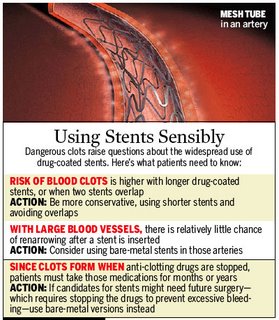The Dangers of Stents

The function of the small metal tubes known as stents is to prop open narrow arteries. Once a stent is inserted, the blood vessel grows new layers of cells over the metal as part of the healing process. That's a good thing, but problems arise when the healing is too vigorous and the resulting layer of cells is too thick. The vessel narrows, causing symptoms like chest pain. Current thinking is that 15% to 30% of patients who get first-generation bare stents will have this problem, called restenosis, although one new study suggests that the rate could be as low as 8%.
That's why researchers have been seeking ways to tame the over-exuberant healing process. The first promising approach, embraced by cardiologists in the 1990s, was zapping blood vessels with radioactive seeds for a short time after stents were inserted. Virmani, then head of cardiovascular research at the Armed Forces Institute of Pathology, was skeptical. The radiation would only delay restenosis, she warned, while damaging the vessel and leading to other ills, like clots. After being a lonely voice of caution for years, "I was proven right," she says.
Now doctors typically use drug-coated stents instead of radiation. Millennium Research Group estimates 920,000 patients in the U.S. will get them this year. The drugs--an anti-cancer agent in Boston Scientific's Taxus and a potent immune-system suppressant in Cypher--are secreted by a plastic polymer in the stent to slow healing.
The problem is that "delaying healing is a double-edged sword," Virmani explains. Examining stents under the microscope months after they were implanted, Virmani often finds that no new protective layer of cells has formed. As a result, the body still views the site of the stent as an unhealed wound, so it sends in a clotting protein to speed the healing. That, in turn, can lead to a deadly clot, called a thrombus. What's more, work by Virmani and others shows that the polymer itself can trigger an inflammatory response, compounding the problem.
1





0 Comments:
Post a Comment
<< Home